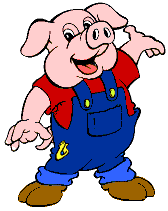How To Smoke Pork Ribs

Modern cooking can be so sterile with microwaves and and electric ovens, but when we smoke meat, we connect to the past. We smoke meat today for enhanced flavor and tenderness, but the same technique was used in earlier times to preserve meat, such as in smoke houses. Smoking ribs will always produce a superior product. How many microwave rib cook-offs have you heard of? Exactly.
Acid Rain and Smoked Ribs...Yum!
Believe it or not, when we smoke properly and get that sought-after smoke ring, we are witnessing the same chemical reaction as in acid rain. Nitrogen Dioxide from the smoking wood combines with water (moisture) and pigments in the meat to form that pink color or 'smoke ring' that says, 'Dive in.' Acid and trees? Disaster. Acid and ribs? Great food.
That's why the water pan is so important, right?
Notice I said that the smoke ring is formed in part from the moisture in the meat. That's not to say that the water in the water pan actually adds moisture to meat. The water can help keep the moisture level in the smoker within a range that helps prevent the meat from drying out by quickly boiling out its juices.
I know that may sound like I'm being picky, but think about water's potential to be a rogue element in your smoker: it's a hassle to replenish it, it can make a nasty soot fall onto your ribs (from condensation), and worse, it can contribute to the formation of a nasty junk called creosote.

Here's my tip for your water pan troubles-
If you're tired of trying to frequently add the right amount of HOT water without losing your heat in your smoker AND avoid condensation problems, wrap your water pan in heavy duty foil before filling it, and put a layer over the top of the water with a few small slits or holes in it. You will then be able to control the moisture better and to avoid opening the smoker so often. to top
Creosote - for power poles and railroad ties
 Creosote is an oily, gooey, greasy mess that can form on your meat and smoker's inside. It will kill good meat every time. Moisture and incomplete combustion caused by varying factors leads to creosote condensing out of the smoke when smoking pork ribs. You may have heard that creosote in chimneys comes from burning wood with too much pitch, like pine. Pitch is not the factor; it's the moisture in the pitch, and the temperature of the surfaces where the moisture and combustion gasses go.
Creosote is an oily, gooey, greasy mess that can form on your meat and smoker's inside. It will kill good meat every time. Moisture and incomplete combustion caused by varying factors leads to creosote condensing out of the smoke when smoking pork ribs. You may have heard that creosote in chimneys comes from burning wood with too much pitch, like pine. Pitch is not the factor; it's the moisture in the pitch, and the temperature of the surfaces where the moisture and combustion gasses go.
Control these factors when smoking pork ribs, and you can avoid creosote: 1) combustion 2) moisture 3) ventilation
Causes of creosote:
- -green, wet, unseasoned wood
- -a smoldering fire with few coals
- -adding too much cold fuel on low fire
- -too much wood added to few coals
- -green, wet, unseasoned wood
- -too much cold meat, cools smoke
- -cold outside temps
- -water pans
- -cold water to water pans
- -low oxygen - choking fire
- -fire temp too low for swift exhaust
- -no exhaust vents
- -poor air circulation (time to condense)
- -controlling temp too much with exhaust instead of intake
Let's move on to: Best Wood For Smoking Ribs / Wood Tips